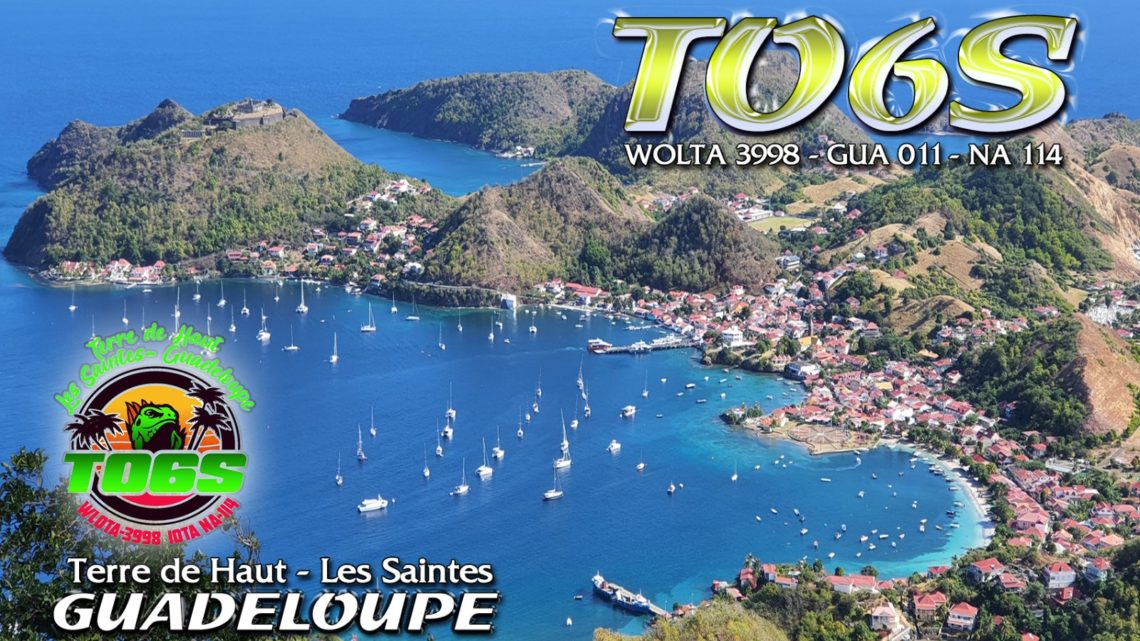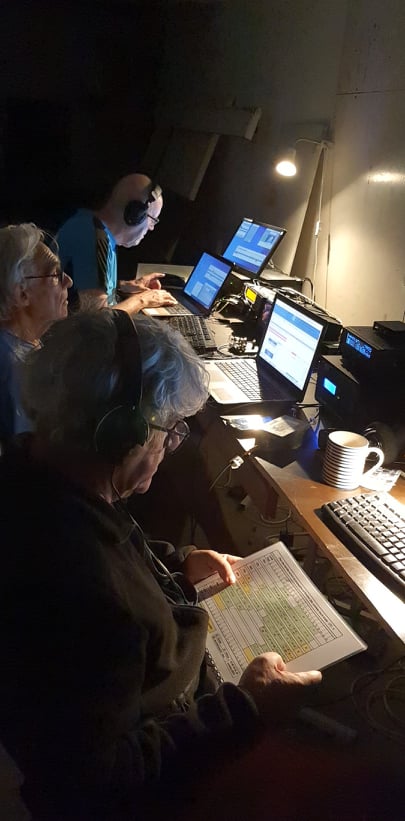
TO6S, 8 days of adventure with 20,000 QSOs
The outward journey

Our departure originally scheduled for January 20 had to be brought forward by one day because of the cancellation of our flight. So we left Burgundy on the 19th, and after a night in a hotel in Orly, we landed in Pointe à Pitre on the 20th in the early afternoon, where we found Keith VE7KW.
300 kilos of luggage in hand, our big taxi took us to our stopover in Trois Rivières, Basse Terre. Early the next day, boarding of the freight and the 5 operators on the boat for the crossing to Les Saintes. On arrival, 18 pieces of luggage to be carried by hand over 400m in order to load our taxi because the center of the village is prohibited for all vehicles, even bicycles… 2 round trips were necessary to reach our villa.

Installation

Warm welcome by our hostess Brigitte at the superb Villa Hibiscus Rose in Terre de Haut. The villa is comfortable and has an exceptional panorama.
We thought we could exploit 5000 m² of land, but in a few years a thick vegetation of thorny trees settled down, reducing the useful surface for the antennas to 1500m². It was difficult to mount the Quad 2el, the LPDA 12el, the verticals 40m, 80m, and the Linv 160m on such a small surface, and we had to sacrifice the Moxon which was replaced by a dipole for the 30m. Moreover, it was impossible to install the 60m dipole without disturbing the LPDA.
The stations were set up in a small technical room in the basement open to nature.
Traffic
If the DXCC FG is not rare, the IOTA NA114 is much more so, but from our first calls we were surprised by the interest that the Amateur Radio community took in our Expedition. We started with big pile ups on all bands. In CW we sometimes listened up to 10KHz above our QRG and up to 20KHz in SSB.
Despite 2 or 3 computer bugs quickly repaired, no power outage or radio failure to deplore. The antennas held up well to the wind: the westerly trade winds which blew up to 60 km/h. The Quad 2 elements, the most fragile antenna, withstood the onslaught of the wind as well as the squalls.
The superb CW pile ups with our Japanese friends delighted us. To underline the great intelligence of their traffic in DX with a systematic spreading of their calls on 10Khz allowing to contact many small stations. The rather weak signals limited the amount of traffic.
With our friends in North America and Central America, excellent signals from S9 to S9++ allowed a number of contacts.
South America was more complicated to contact, Mont Chameau at an altitude of 320m on which the south of our Villa leaned was undoubtedly the source of the problem. Despite everything, good contacts were established with all the countries of the South.
The whole of Europe was there. It was a great pleasure to contact you, even if you were hundreds of operators focused on 500Hz, sometimes making listening impossible. On the other hand, we were able to make excellent QSOs with those who called 3 or 4 KHz above. Many small stations were contacted including mobile stations and QRP¨…
Our French friends have often brightened up our QSOs with a little BJR or BSR, and MCI is always a pleasure. Thank you to all those who understood that getting out of the big pile up considerably increased the chances of contacts.
Terre de Haut

Even if there are many tourists, the island of Terre de Haut is magnificent.
Many yachtsmen come to relax in this sublime bay, and if the village is teeming with people, as soon as you start hiking Mont Chameau, there is no one left… Le Chameau, 320m above sea level, presents a view panoramic view of the Saintes archipelago and allows you to take in Guadeloupe, Marie Galante and Dominica… What a magnificent sight! We must also note the emotion that awaits, when at the bend of a path, we find ourselves face to face with iguanas. If their wild beauty has remained unchanged for millennia, their mischievous eyes seem to offer a knowing smile to the walker.
Renting an electric bike allows you to visit the island in detail, F1TCV our dean opened the road from the top of his 78 springs. Otherwise an electric cart will do the trick.
Many beaches allow swimming in turquoise water at 26°C in the month of January and the snorkeling tour of Sugar Loaf will have immersed us in a natural aquarium of rare beauty.
The return trip
Departure on February 2 at 5:45 a.m. to take the boat to Guadeloupe where our big taxi was waiting for us… 5 hours of patience in a deserted airport where everything was closed, including the waiting areas. We felt a certain form of abuse, outside in the sun, unable to move away from our luggage. Finally we board for an uneventful flight. We collect our car and its trailer for a return in the Burgundy mist…
Conclusion
The Team would like to particularly thank the vast majority of the amateur radio community for their “Ham Spirit” during your calls, emphasizing the traffic discipline that you have largely respected. We simply regret the lack of understanding of our instructions UP 1 to 5 in CW that few of you have integrated and respected. If your calls had been spread over 5KHz, we would have contacted a few thousand more of you.
Equipment
No breakdown is to be deplored, except for the switch of the Cubical Quad 5 bands which was changed in 1 hour.
Stations :
- STN 1 K3 + Panadapter – 500W amp with Keith VE7KW ATU for SSB and CW
- STN 2 K3 + 500W amplifier by Didier F6BCW for SSB and CW
- FT450 + Pierre F1TCV 500W amplifier for digital modes
Antennas :
- 1 Cubical Quad 2 elements 5 bands (10 to 20m)
- 1 LPDA 12 elements 5 bands (10 to 20m)
- 1 dipole 30*
- 1 vertical 40m
- 1 vertical 80m
- 1 vertical in Linv for the 160m.
Note that all the antennas have been specially built by the team for the DX’P.
Sponsors

A big thank you to the dozens of radio amateurs who sent us a donation.
A big thank you also to our French Sponsors, the private companies of our Burgundy region.
Finally, a big thank you to the Amateur Radio Associations who supported us, the REF, the Clipperton, the UFT, the Frasel, the ARAC and a special mention to the only foreign Sponsor who responded to our request for help: the Chiltern DX Club (CDXC-UK).
We really regret the lack of support from other foreign amateur radio sponsors that we have solicited. Too bad, with more subsidy, we could have stayed 5 more days and made a lot more QSOs.
F6BCW Didier






